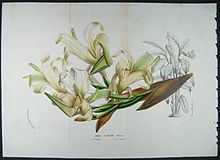Family Cannaceae Rank Species | Genus Canna Higher classification Canna | |
 | ||
Similar Canna pedunculata, Canna jaegeriana, Canna, Canna iridiflora, Canna tuerckheimii | ||
Canna liliiflora is a species of the Canna genus, a member of the family Cannaceae, and a native of Peru and Bolivia. It is a perennial growing to 3m. It is hardy to zone 10 and is frost tender. In the north latitudes it is in flower from August to October, and the seeds ripen in October. The flowers are hermaphrodite (have both male and female organs).
Contents
Synonyms
Taxonomy
In the last three decades of the 20th century, Canna species have been categorised by two different taxonomists, Paulus Johannes Maria Maas from the Netherlands and Nobuyuki Tanaka from Japan. Both taxonomists are in agreement that C. liliiflora is a distinct and separate species.
Canna liliiflora Warsc. ex Planch.
(Lily-flowered). Flower 10–13 cm. (4-5") long, Honeysuckle-scented, in a short, terminal raceme; perianth tubular, the three outer petaloid lobes linear-oblong, convolute, reflexed, tinged green, the three inner ones straight and extended, recurved at end, white, tinted yellowish-green. Leaves large, Musa-like, oblong, acuminate. Stems stout, erect. Height 2–3 metres (6-10feet) A fine plant. (F.d.S. 1055-6; R. H. 1884, 132.)
Cultivation
The species prefers light (sandy), medium (loamy) and heavy (clay) soils and requires well-drained soil. The preferred soil is acid, neutral and basic (alkaline). It cannot grow in the shade and requires moist soil.
